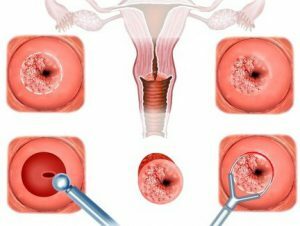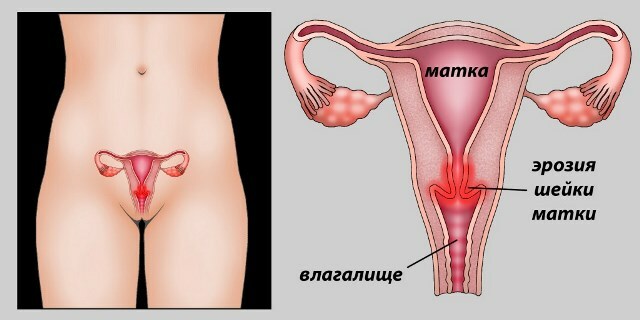Many women are interested in this method of treatment, like cauterization of erosion of the cervix with liquid nitrogen. Immediately say that this procedure is much more often performed in the so-called pseudo-erosion - a disease that, without treatment, can be transformed into a malignant tumor. Simple erosion in the vast majority of cases does not require surgical intervention.
What is cryodestruction
Cauterization of erosion by nitrogen is an intervention aimed at destruction of affected cervical tissue with the help of cooled gases. Simply put, a small area of the organ is frozen and then rejected. Synonyms for such intervention can be called cryoablation, cryotherapy.

Therefore, before the cryodestruction, the patient should be carefully examined. The purpose of this diagnosis is to exclude the early stage of cervical cancer, after all, after the performed manipulation to confirm or exclude it will be much more difficult.
Moxibustion of erosion with liquid nitrogen for the treatment of pseudo-erosion was widespread in the 1980s. Advantages of the method are simplicity, safety and low cost. Used liquefied gas with a very low boiling point, that is, the transition to a gaseous state. It can be liquid nitrogen, nitrous oxide, carbon dioxide.
Liquefied gas passes through the long channel of the device, and then falls into a wide tip. There it almost instantly passes into a gaseous state, which, according to the Joule-Thompson effect, causes a rapid cooling of the apparatus.
Most cryodestruction devices are designed to use nitrous oxide. It "boils" at a higher temperature than liquid nitrogen, and it can be stored in a closed container. The liquid substance itself is practically not used, because it is stored only in an open tank, where it quickly evaporates into the environment.
Moxibustion of cervical erosion with nitrogen occurs at a tissue temperature of -20 degrees and a freezing depth of 5 mm. The adjacent plots also freeze, but after thawing they restore their properties. This depth is considered sufficient for small lesions. However, with severe cervical intranoplasia, in particular, observed during pseudo-erosion, not all pathological cells can be removed in this way.
Procedure for performing the procedure
Manipulation is performed on an outpatient basis. After it is completed, the patient may be sent home after a while. Special training is not required.
Before the intervention, the woman is explained its essence, she signs a voluntary informed consent for its conduct. Pre-warn the woman of possible unpleasant effects, such as a rush of blood to the face or pulling pains in the lower abdomen.
To facilitate these manifestations an hour before the procedure, you can take a non-steroidal anti-inflammatory drug, for example, ketoprofen or indomethacin.

Cauterization of cervical erosion
Treatment of cervical erosion with nitrogen( if more precisely, pseudo-erosion) is best performed immediately after the end of menstrual bleeding. Anesthesia does not require intervention.
The patient is located on the gynecological chair. The cervix is opened with the help of vaginal mirrors and a "Lugol" solution is applied to it to accurately determine the site of exposure. If necessary, place additional moisturize with physiological solution. Then a warm probe tip is inserted into the vagina and pressed tightly against the affected area.
After this, the tissues freeze, which lasts from 3 to 5 minutes. After thawing, the tip is removed. For faster recovery, the neck is sometimes additionally irrigated with a warm saline solution. With a large amount of damage it is possible to conduct a repeated cryodestruction of the site located next to the treated one.
The patient should be reminded of the need to abstain from sexual intercourse within a month after cryotherapy.
Advantages of nitrogen cauterization
This method of treatment has been used for a long time, and there is a lot of experience in its use in gynecological patients. The advantages of cryotherapy are the following:
- low cost;
- painless;
- no long recovery period;
- bloodlessness and minimization of the risk of infection with infectious diseases;
- intermittent intervention;
- absence of cicatricial cicatricial deformity, which allows cryotherapy for nulliparous patients;
- in most cases - safety, good tolerability, no complications.
Negative consequences of cryodestruction
Treatment of erosion with nitrogen is often accompanied by loss of pulse and even fainting. In some cases, cramps are possible. To prevent such an adverse effect after the intervention, the woman should be in a prone position for some time, the nurse observes her condition, measures blood pressure and heart rate.
During the first two days after manipulation, painful abdominal pain is possible, which can be eliminated by taking an anesthetic that the doctor recommends( eg, diclofenac for 3 to 5 days).Often well, not pills, but suppositories with nonsteroidal anti-inflammatory drugs, are good.
One of the unpleasant complications is the hydro-ridge - copious watery discharge from the genital tract, which persists for a month after the procedure. Also, the patient may have small bloody discharge, but profuse bleeding occurs extremely rarely.
Finally, a rare but serious complication of cryodestruction of the cervix is stenosis( constriction) of the cervical canal. Sometimes there is a complete "infection", which causes a violation of the outflow of blood during menstruation and requires an operation to restore its patency.
 We recommend reading the article about the consequences of cauterization of cervical erosion. From it you will learn about the time necessary for healing, about the sensations of a woman after the procedure, the peculiarities of the rehabilitation period.
We recommend reading the article about the consequences of cauterization of cervical erosion. From it you will learn about the time necessary for healing, about the sensations of a woman after the procedure, the peculiarities of the rehabilitation period.
Contraindications to the use of
Cryotherapy is not performed in the following situations:
- cervical cancer;
- pregnancy and the period of breastfeeding;
- vaginitis, colpitis, cervicitis;
- menstrual or other uterine bleeding;
- the size of the lesion is more than 3 cm;
- cervical deformation, which interferes with the tight fit of the tip;
- cryoglobulinemia.

Price of the service
Depending on the equipment, the clinic where the intervention is performed, often the cost of cryotherapy of the cervix is from 1000 to 3000 rubles, depending on the qualification of the specialist and also in different regions of Russia. In Ukraine, the price for this type of treatment starts from 100 hryvnia.
Cryodestruction of cervical pseudo-erosion is not included in the standards of assistance guaranteed by the state in the system of compulsory medical insurance. In other words, even in an ordinary female consultation, if there is adequate equipment in it for intervention, you will have to pay yourself.


Ask your question to an obstetrician for a gynecologist!